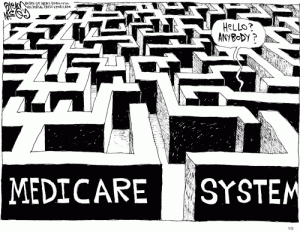I and many others are convinced that once the Baby Boomers hit the assisted living age sweet spot, the nation will be faced with a massive affordability (and maybe inventory) crisis.
During and immediately following ALFA I got a chance to interview a number of senior living leaders but because of an intense travel schedule I have fallen behind with the writing part. Catch-up time is here. I hope you enjoy the perspectives as much as I enjoyed doing the interviews.
One of the leaders I have hoped to meet for a long time is Rod Burkett the CEO of BMA Management a senior living provider in Bradley, Illinois, that develops and operates affordable Medicaid Waiver assisted living communities. I was standing in line to get my name badge and there he was with Wayne Smallwood, executive director of the Affordable Assisted Living Coalition. This is a two part article with Part 1 laying the foundation for affordable assisted living framework. Part 2 will be the actual interview.
Low Income Assisted Living
I and many others are convinced that once the Baby Boomers hit the assisted living age sweet spot, the nation will be faced with a massive affordability (and maybe inventory) crisis. The problem will fall into two buckets:
- There will be Boomers who made good to great incomes which will translate into maximum social security benefits, plus along the way, and mostly by accident, they will have managed to accumulate some IRA and 401K savings that will generate only very small amounts of additional income.
It is likely this group will turn out to be most difficult to serve.
- There will also be massive numbers of seniors who have essentially no assets and minimal or in some cases no social security income. These are the “dual eligibles” meaning there incomes are so low they qualify for both Medicaid and Medicare. Even today, this group is sizeable making up around 85% of the total skilled nursing population.
The Dual Eligible Problem
Historically when a low income individual had a need for anything except very limited nursing care that could be provided via home health, their only way to access those services was by moving into a skilled nursing facility. This turned out to be a bit of a windfall for the skilled nursing facility because those residents required lower levels of nursing care. It also meant the government system was paying a lot of money for a relatively low level of services.
Waiver Program
The federal government has a number of waiver programs that will allow Medicaid moneys to be diverted to programs that have the potential of providing better service at a lower cost. One of those wavier program allows states to create a program where a portion of the Medicaid dollars that would have otherwise been used to pay for skilled nursing are used to provide/pay for intermittent skilled nursing, nursing oversight and personal care services in assisted living communities.
The bottom line goal of this particular waiver program is to move or divert appropriate residents from skilled nursing to assisted living where they can get equivalent (or better) nursing care in a higher quality environment and at a lower cost to the government. This becomes a win for everyone except perhaps the skilled provider who lose access to the easiest to care for residents.
Part two will take a look at the 6 trigger points that BMA Management uses in determining whether or not a state or specific location makes sense for a low income waiver senior living community.
Steve Moran









Interesting paradigm with the UK elder care market. We too, are very much in flux at the moment, with a new ‘Care Bill’ regarding funding due in 2016. I wonder if Obama and Cameron have discussed it over a cup of tea?
Unfortunately, Medicaid waivers that apply to long term care diversion, or assisted living sound better than they perform. Florida alone has a hideous system with at least 5,000 on a waiting list for Medicaid that applies to ALFs right now. Florida has ceased the dedicated waiver program and made everything Managed Care Medicaid. That has resulted in delayed payments to ALFs that can only be paid for services, by the way, which in turn has resulted in residents being discharged for lack of payment.
In Florida Medicaid pays only for services, and since ALFs also provide room and board, there is a loophole that allows ALF operators to raise the cost of room and board to make us the difference that they are not being paid for services through Medicaid.
Medicaid paying for LTCD programs or ALF services is not a viable option in many other states, as well.
Having long term care insurance, planning and saving for retirement, and investing wisely (especially in the aftermath of the chaos we’ve been through) are the only real ways boomers are going to be able to afford good care in an ALF.
The alternative of course, is that NH will become jammed with boomers because once a boomer is unsafe at home, the state will step in and force the placement issue. Once the state steps in and requires that services be put in place to protect the health, safety and welfare of a vulnerable adult, the only answer is NHs almost all the time.
As a director of 1 95% and 1 100% Medicaid communities in Washington State I have found our system to be somewhat financially viable and at times a bit profitable to the NOI. Nothing like a private pay community, but, it CAN be done.
Our system helps seniors obtain housing by using Section 8 housing and project based vouchers. We also have utilized Low Income Housing Tax Credits (LIHTC) in conjunction with Section 8 vouchers to build and operate.
This was made possible through our local housing authority and the team at HUD.
Minor savings occur in labor costs due to not having a “marketing” team. All seniors are referred in by their Medicaid caseworker. Needless to say, due to a shortage in available units, there is always a healthy waitlist and any turnovers are less than 14 days. Keeping census full consistently.
It helps keep adults as independent and safe for as long as possible before looking at SNF or AFH placement-thus providing a significant cost reduction to the healthcare system.
In our area, there is a steep need for dementia and alzheimers Medicaid beds. There simply are not enough providers for the amount of seniors needing specialized care and many of them go to nursing homes for their end stage and end of life care.
Its an issue the federal and state governments must look at and soon.
No one is getting any younger. If its not addressed at the federal level with more funds or tax credit savings allocated to build new or convert old housing structures, (in addition to offering monies to State Medicaid programs), there will surely be a crisis. I do not, however see our nation putting our elders on the street to fend for themselves. Ultimately the crisis will fester and push from inside and will force government to address it.